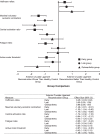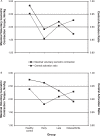Quadriceps Neuromuscular Function in Patients With Anterior Cruciate Ligament Reconstruction With or Without Knee Osteoarthritis: A Cross-Sectional Study
- PMID: 29893603
- PMCID: PMC6107773
- DOI: 10.4085/1062-6050-102-17
Quadriceps Neuromuscular Function in Patients With Anterior Cruciate Ligament Reconstruction With or Without Knee Osteoarthritis: A Cross-Sectional Study
Abstract
Context: Central and peripheral neural adaptations have been identified after anterior cruciate ligament (ACL) injury and reconstruction (ACLR) and are hypothesized to contribute to posttraumatic muscle dysfunction. Limited evidence exists about the temporal nature of neuromuscular adaptations during early and late-term phases of recovery after ACLR, and no researchers have studied patients with posttraumatic osteoarthritis.
Objective: To compare quadriceps neuromuscular function less than 2 years ( early) and more than 2 years ( late) after ACLR, including in patients who experienced posttraumatic knee osteoarthritis.
Design: Cross-sectional study.
Setting: Laboratory.
Patients or other participants: A total of 72 patients after ACLR, consisting of 34 early (9.0 ± 4.3 months postsurgery), 30 late (70.5 ± 41.6 months postsurgery), and 8 with osteoarthritis (115.9 ± 110.0 months postsurgery), and 30 healthy control volunteers.
Main outcome measure(s): Quadriceps function was measured bilaterally during a single visit to determine normalized Hoffmann reflex (H : M ratio), knee-extension maximal voluntary isometric contraction torque (Nm/kg), central activation ratio (%), fatigue index (% decline), and active motor threshold (%). Comparisons were made using 2-way analyses of variance to identify the effect of limb and group on each outcome measure. We calculated Cohen d effect sizes to assess the magnitude of difference between ACLR and matched control limbs for each group.
Results: Compared with healthy control limbs, involved-limb maximal voluntary isometric contraction was lower among all patients after ACLR ( P < .001, Cohen d values = -1.00 to -1.75). The central activation ratio ( P < .001, Cohen d = -1.74) and fatigue index ( P = .003, Cohen d = -0.95) were lower among patients only early after ACLR. The active motor threshold was higher among all patients after ACLR ( P < .001, Cohen d values = -0.42 to -1.56).
Conclusions: Neuromuscular impairments were present in patients early and late after ACLR, regardless of osteoarthritis status. Quadriceps strength and corticospinal excitability were impaired at each time point compared with values in healthy control individuals, suggesting the need to address cortical function early after ACLR.
Keywords: corticospinal excitability; muscle activation; spinal-reflex excitability.
Figures


Similar articles
-
Quadriceps Neuromuscular Function and Jump-Landing Sagittal-Plane Knee Biomechanics After Anterior Cruciate Ligament Reconstruction.J Athl Train. 2018 Feb;53(2):135-143. doi: 10.4085/1062-6050-306-16. Epub 2018 Jan 19. J Athl Train. 2018. PMID: 29350554 Free PMC article.
-
Quadriceps Function and Patient-Reported Outcomes After Anterior Cruciate Ligament Reconstruction in Patients With or Without Knee Osteoarthritis.J Athl Train. 2018 Oct;53(10):965-975. doi: 10.4085/1062-6050-170-17. Epub 2018 Oct 5. J Athl Train. 2018. PMID: 30288991 Free PMC article.
-
Unilateral Quadriceps Strengthening With Disinhibitory Cryotherapy and Quadriceps Symmetry After Anterior Cruciate Ligament Reconstruction.J Athl Train. 2017 Nov;52(11):1010-1018. doi: 10.4085/1062-6050-52.10.13. J Athl Train. 2017. PMID: 29257714 Free PMC article.
-
Quadriceps Strength and Volitional Activation After Anterior Cruciate Ligament Reconstruction: A Systematic Review and Meta-analysis.Sports Health. 2019 Mar/Apr;11(2):163-179. doi: 10.1177/1941738118822739. Epub 2019 Jan 14. Sports Health. 2019. PMID: 30638441 Free PMC article.
-
Progressive Changes in Walking Kinematics and Kinetics After Anterior Cruciate Ligament Injury and Reconstruction: A Review and Meta-Analysis.J Athl Train. 2017 Sep;52(9):847-860. doi: 10.4085/1062-6050-52.6.06. J Athl Train. 2017. PMID: 28985125 Free PMC article. Review.
Cited by
-
Somatosensory perturbations influence cortical activity associated with single-limb balance performance.Exp Brain Res. 2022 Feb;240(2):407-420. doi: 10.1007/s00221-021-06260-z. Epub 2021 Nov 12. Exp Brain Res. 2022. PMID: 34767059
-
Investigating the effects of previous injury on subsequent training loads, physical fitness, and injuries in youth female basketball players.Front Physiol. 2025 Jan 23;16:1506611. doi: 10.3389/fphys.2025.1506611. eCollection 2025. Front Physiol. 2025. PMID: 39917078 Free PMC article.
-
Hop tests can result in higher limb symmetry index values than isokinetic strength and leg press tests in patients following ACL reconstruction.Knee Surg Sports Traumatol Arthrosc. 2020 Mar;28(3):816-822. doi: 10.1007/s00167-019-05513-3. Epub 2019 Apr 25. Knee Surg Sports Traumatol Arthrosc. 2020. PMID: 31025059 Free PMC article. Clinical Trial.
-
Slacklining as therapy to address non-specific low back pain in the presence of multifidus arthrogenic muscle inhibition.World J Orthop. 2021 Apr 18;12(4):178-196. doi: 10.5312/wjo.v12.i4.178. eCollection 2021 Apr 18. World J Orthop. 2021. PMID: 33959482 Free PMC article. Review.
-
Integrating frequency and dynamic characteristics of EMG signals as a new inter-muscular coordination feature.Phys Eng Sci Med. 2025 Aug 21. doi: 10.1007/s13246-025-01620-3. Online ahead of print. Phys Eng Sci Med. 2025. PMID: 40839231
References
-
- Ardern CL, Taylor NF, Feller JA, Webster KE. Fifty-five per cent return to competitive sport following anterior cruciate ligament reconstruction surgery: an updated systematic review and meta-analysis including aspects of physical functioning and contextual factors. Br J Sports Med. 2014;48(21):1543–1552. - PubMed
-
- Oiestad BE, Juhl CB, Eitzen I, Thorlund JB. Knee extensor muscle weakness is a risk factor for development of knee osteoarthritis: a systematic review and meta-analysis. Osteoarthritis Cartilage. 2015;23(2):171–177. - PubMed
MeSH terms
LinkOut - more resources
Full Text Sources
Other Literature Sources
Medical

